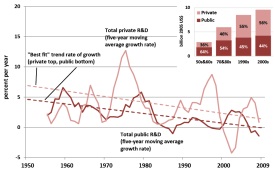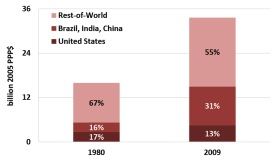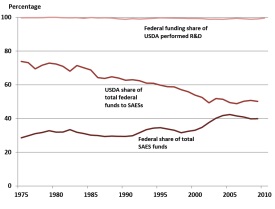
A large part of U.S. agricultural output and its competiveness in international commodity markets is attributable to research-induced gains in productivity accumulated over the 20th century. In 2012, the United States accounted for a sizable share (9.5% by value) of the global food, feed, and fiber economy. This is substantially smaller than its 1961 share of 14.8% (United Nation’s Food and Agriculture Organization (FAO), 2014). Over the same period, the Asia-Pacific region (including India and China) grew its global share from 24.2% to 45.1%. Productivity growth in U.S. agriculture has declined along with its global market share. For the post-World War II period through 1990, agricultural productivity—measured by accounting for changes in the use of multiple factors of production—grew on average by 2.1% per year, but dropped to almost half that rate (1.2% per year) during the subsequent two decades (Pardey, Alston, and Chan-Kang, 2013).
As the 21st century unfolds, a question of major importance is whether a continuation of contemporary trends in public investments in research and development (R&D) are sufficient to preserve or enhance past productivity gains and ensure the United States remains competitive in global agricultural markets (Alston et al., 2010, especially chapter 11). While the links between R&D investments and changes in productivity are difficult to disentangle, there is compelling evidence that these investments continue to yield relatively large social dividends (Hurley, Rao, and Pardey, 2014), but with several major, and politically crippling, caveats. The lags between investing in R&D and realizing returns on those investments are long (often spanning decades), and the benefits are diffuse, accruing to a broad range of producers and consumers, and not limited to any particular political jurisdiction or constituency. It is, therefore, harder for politicians to reap short-term electoral benefits by acting in a far-sighted fashion for the country’s long-run economic and environmental gains. Nevertheless, decisions taken now will have potentially profound consequences for U.S. and global agriculture at least through the middle of this century.
So how have political commitments to the public investments in R&D that affect the food and agricultural sectors fared of late? Are the institutional arrangements for funding and performing public agricultural R&D evolving in ways that will lead to a robust future for U.S. agriculture? Are the investment and institutional changes envisaged in the 2014 Farm Bill sufficient in light of substantive shifts in the roles of public versus private R&D within the United States, and the position of the United States in global innovation markets for food and agriculture?
We examine the 2014 Farm Bill for recent evidence on the changing landscape of U.S. agricultural R&D policies and practices. But the new farm bill is not the only source of relevant evidence: reviewing past investment trends also yields insights, especially given the generally long lags between R&D activity and substantive economic outcomes. It is also important to place farm bill developments in the context of evolving private sector roles and other changes in arrangements for prioritizing and funding public research.
Against a backdrop of a projected, but perhaps unrealistic, prediction of reductions in total federal government funding for agriculture, the Agricultural Act of 2014 yielded modest increases in funding for public food and agricultural R&D. The U.S. Congressional Budget Office (CBO) credited the 2014 Farm Bill with a budget savings of $16.6 billion over the next 10 years, even with a $1.3 billion increase in agricultural R&D funding over that 10-year period (CBO, 2014). This increase in nominal funding is a break from recent trends that at first blush, looks promising for the future of U.S. agriculture. However, the funding increase is unlikely to make a substantive difference in the performance of public food and agricultural R&D.
Pardey, Alston, and Chan-Kang (2013) concluded that “evidence on returns [to public R&D spending] suggests it should be socially profitable to at least double the total annual investment, but it would make sense to phase in any major increase over 5-10 years given the current limitations on capacity of the system that have arisen from past funding and spending patterns.” The additional R&D funding authorized in the 2014 Farm Bill falls far short of doubling public support for the agricultural sciences. It constitutes an average nominal increase of just $130 million per year, equivalent to an average annual increase of only 2.8% of total U.S. public R&D spending for food and agriculture (relative to the 2009 total, the latest year such national spending totals are available). Moreover, for every extra dollar invested in R&D over baseline funding by way of the 2014 Farm Bill, the CBO estimates that $30 to $50 additional will go to public subsidies for new crop insurance and “shallow loss” risk management programs. While R&D demonstrably grows the agricultural pie—yielding economic returns of around $20 for every $1 invested (Alston et al., 2010)—public support to crop insurance (and, especially, the large subsidy component of that public support) largely redistributes the existing economic pie (Smith and Glauber, 2011).

Source: Pardey, Chan-Kang, and
Dehmer, 2014.
The relatively small gains in nominal R&D spending prescribed in the farm bill fail to redress the rundown in U.S.public research capacity witnessed of late. Adjusting for inflation, the rate of growth in U.S. public food and agricultural R&D spending has been declining for the past three and a half decades (Figure 1). During the 1950s and 1960s, inflation-adjusted spending on public food and agricultural R&D grew by 3.7% per year on average; from 2000-09, it grew by just 0.05% per year. Since 2002, the United States has actually been divesting itself of public food and agricultural R&D: in real terms (2005 prices), spending in 2009 ($4.07 billion) was less than it was in 2002 ($4.36 billion). Growth in private food and agricultural R&D spending has generally been faster than the growth in public spending. Thus, a larger share of U.S. food and agricultural R&D is now done by the private sector (36% of the total in the 1950s and 1960s versus 56% during the 2000s).
The United States has also fallen behind in terms of its public research spending in a global context. In 1980, the United States accounted for 17% of the $15.9 billion (2005 PPP prices) invested in public food and agricultural R&D worldwide, more than the combined spending of Brazil, India, and China (BIC) (Figure 2). By 2009, the U.S. share of the $33.6 billion (2005 PPP prices) global total had shrunk to 13%, well behind the corresponding BIC share of 31%. As these spending differentials gradually translate into differences in relative innovative output and relative productivity, the United States will increasingly lose its competitive edge in global food and agriculture markets.

Not all publicly performed food and agricultural R&D is funded by way of the farm bill. So how critical is the farm bill—and federal government support more generally—to spurring technical and economic growth in the U.S. farm and food sectors?
Over the past several decades, around one-third of all public food and agricultural R&D was performed as intramural research by the U.S. Department of Agriculture (USDA) and about two-thirds of the research was done in the State Agricultural Experiment Stations (SAESs). Federal government support accounted for almost all funding for the USDA’s intramural research (Figure 3).

Source: Pardey, Chan-Kang, and
Dehmer, 2014.
The story is more complicated for the SAESs. As state government support for SAES research has waned in many states (accounting for, on average, 61% of the total in 1975, down to just 38% in 2009), the federal government share has grown (from 29% up to 40% over the same period). Funding authorized by Title VII of the farm bill for support of the SAESs accounts for a consistently declining share of total federal support to SAES research (74% in 1975 and 50% in 2009).
The growing share of funding to the SAESs accounted for by other federal government agencies (including the National Science Foundation (NSF), National Institutes of Health (NIH), U.S. Department of Defense, U.S. Environmental Protection Agency, and others) somewhat offsets the shortfall in Title VII funding, but with two potentially adverse effects. First, as funding from other (non-USDA) agencies has grown, research priorities have been increasingly determined by those other funding agencies which, generally, have less, if any, interest in research directly targeted to increasing farm productivity. Little surprise then that Pardey, Chan-Kang, and Dehmer (2014) report a substantial decline in farm productivity-oriented research carried out by the SAESs, from 65% of the total in 1976 to 56% in 2009. Second, it means that the overall funding for SAES research becomes increasingly sensitive to the funding futures of these other agencies. Hence, if the growth in R&D funding from NIH, NSF, and other federal government agencies continues to slow, so too will funding for U.S. food and agricultural R&D.
While the amount and sources of funding matter, so do the institutional arrangements by which this public funding is prioritized, disbursed, and deployed. This especially matters for the efficiency and effectiveness of the overall R&D enterprise in the context of evolving private-sector roles in R&D.
As Pardey, Alston, and Chan-Kang (2013) observed, “Some commentators seem to expect that we can take productivity growth for granted, or that we can rely on the private sector to play all the required roles. But the private sector typically focuses its effort on the development end of the R&D spectrum, with an eye to developing commercial applications of new ideas and technologies, which yield market rewards of increased productivity and profitability for those who develop and deploy the resulting innovations. Much of this effort stands firmly on the shoulders of the more basic, sometimes 'blue sky' research that can have, and demonstrably has had, large social value. Seen from this perspective, public and private R&D are more often complements rather than substitutes, suggesting that, as well as revitalizing public research, attention should be paid to incentivizing public-private linkages rather than cutting back on publicly conducted (as distinct from publicly funded) R&D in the belief that the private sector will fill the void.”
The United States has innovated little in funding publicly performed R&D or in tapping the complementarities of that R&D with the growing amounts of privately performed research. The legislative authority for the creation of the Foundation for Food and Agriculture Research (FFRA), established in the 2014 Farm Bill and made operational on July 23, 2014, has real potential for reshaping public-private partnerships in U.S. food and agricultural R&D. Whether that potential will be fully realized is an open question. FFRA is a non-profit entity with a mandate to solicit non-federal (including private) funding, which is then matched with federal government funding to underwrite research focused on addressing key problems of national and international significance. The private sector has shown a willingness to fund publicly performed food and agricultural R&D (investing $296 million in SAES research in 2009; 8.2% of the SAESs total that year versus 4.9% of the total in 1975). Unfortunately, the 2014 Farm Bill authorized only a limited, one-off, startup allocation of funds in the amount of $200 million (equivalent to only $40 million a year over the anticipated five-year life of the bill) in matching public funds for FFRA, severely curtailing the new agency’s options for leveraging additional public funds in future years. Moreover, expansion of the funding base for publicly performed food and agricultural R&D requires that private funds directed to FFRA be additional to the private funds that otherwise would be invested in SAES research.
A perpetual problem with public food and agricultural R&D funding authorized by a farm bill is the extent to which that funding is earmarked. The new R&D funding authorized in the 2014 Farm Bill continues these past trends, with research funding earmarked for organic research (an additional $100 million over 10 years by CBO accounts) and more than half of the additional R&D dollars ($745 million of the $1.145 billion over the next 10 years) destined for specialty crops research.
Striking the right balance between formula, competitive, and other forms of funding is also a perennial and often contentious problem. Other federal funding agencies (such as NSF and NIH) rely heavily on competitive processes to allocate research dollars, whereas R&D funding made available by way of the farm bill is less reliant on competitive processes (just 5.8% of the total in 2009). This stands in stark contrast to a string of recommendations dating back at least to a 1987 National Research Council (NRC) study (NRC, 2014), which suggested that around 20% of USDA-financed research be allocated on a competitive basis rather than by Congressional fiat.
The National Research Initiative (NRI, established in 1990) and its successor, the Agriculture and Food Research Initiative (AFRI, established in the 2008 Farm Bill), were tentative moves towards more competitive funding of food and agricultural R&D. A recent NRC review of the AFRI program, released on September 9, 2014, finds that, despite some success, AFRI has fallen far short of its intended purposes. The critique can be summarized in three broad categories:
The research title of the 2014 Farm Bill saw a small shift towards redressing the substantial decline in the position of U.S. public agricultural R&D evident over the past two decades. The bill included a modest increase in nominal funding for agricultural R&D, a continuation of R&D earmarks, and the establishment of a new Foundation for Food and Agricultural Research (FFAR)—a non-profit corporation seeded with $200 million in one-time, startup R&D funds to be matched with funding from private and other non-federal sources.
That’s the mildly encouraging good news. The bad news is that the preponderance of the new funding in the farm bill will have income redistribution rather than public-good and productivity-promoting consequences (Goodwin and Smith, 2014). Certainly the comparatively small amount of new funding directed to public research is insufficient to redress the chronic market failure and underfunding that befall U.S. food and agricultural R&D and are unlikely to reverse the dramatic decline in the U.S. share of global public food and agricultural R&D spending. Failing to replenish the stock of public R&D in the face of ever-evolving pests and diseases, climatic uncertainty, and changes in markets that all undermine past R&D-induced productivity gains may have profound adverse consequences for the competiveness of U.S. agriculture.
Alston, J.M., M.A. Andersen, J.S. James, and P.G. Pardey. 2010. Persistence Pays: U.S. Agricultural Productivity Growth and the Benefits from Public R&D Spending. New York: Springer.
Food and Agriculture Organization of the United Nations. 2014. FAOSTAT. Rome: FAO. Available online: http://faostat.fao.org/.
Goodwin, B.K., and V.H. Smith. 2014. “Theme Overview: The 2014 Farm Bill-An Economic Welfare Disaster or Triumph.” Choices, 3rd Quarter. Available online: http://www.choicesmagazine.org/choices-magazine/theme-articles/3rd-quarter-2014/theme-overview-the-2014-farm-billan-economic-welfare-disaster-or-triumph.
Hurley, T.M., X. Rao, and P.G. Pardey. 2014. “Reexamining the Reported Rates of Return to Food and Agricultural Research and Development.” American Journal of Agricultural Economics, 96(5): 1492-1504.
National Research Council. 2014. Spurring Innovation in Food and Agriculture: A Review of the USDA AFRI Program. Washington, D.C: National Academies Press.
Pardey, P.G., C. Chan-Kang, and S. Dehmer. 2014. Global Food and Agricultural R&D Spending, 1960-2009. InSTePP Report. St. Paul: University of Minnesota, in publication process.
Pardey, P.G., J.M. Alston, and C. Chan-Kang. 2013. Public Food and Agricultural Research in the United States: The Rise and Decline of Public Investments, and Policies for Renewal. AGree Report. Washington, D.C.: AGree.
Smith, V.H., and J.W. Glauber. 2011. “Agricultural Insurance in Developed Countries.” Applied Economic Perspectives and Policy 34(3): 363-390.
U.S. Congressional Budget Office. 2014. CBO Estimated Budgetary Effects of H.R. 2642, The Agricultural Act of 2014. Washington, D.C: Congressional Budget Office, January 28. Available online: http://www.cbo.gov/sites/default/files/cbofiles/attachments/hr2642LucasLtr.pdf.